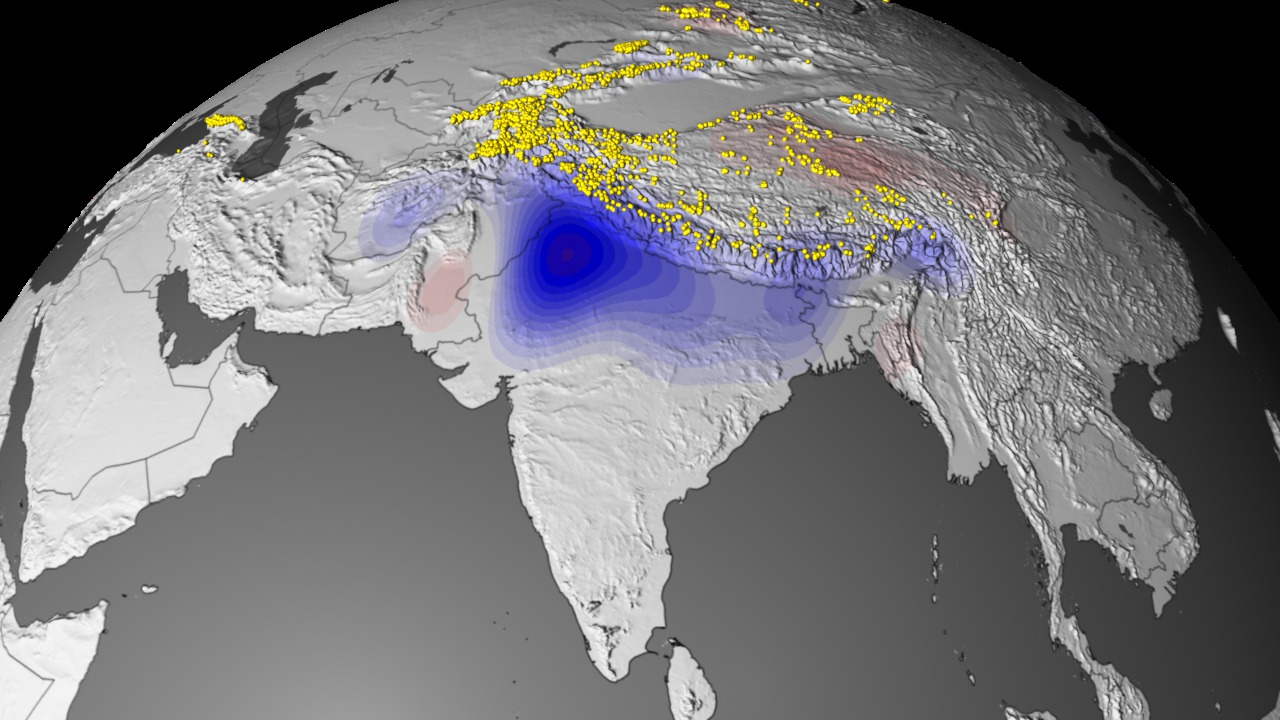Retreating Glaciers And Groundwater
The glacier-covered Himalayas are among the most hostile places on Earth, yet just south of the mountains, India's rapidly growing cities bustle with activity. Despite this contrast, human impact has altered the water and ice inventory of both regions, as measured by NASA's Gravity Recovery and Climate Experiment (GRACE) satellites. Driven by climate change, Himalayan glaciers are losing about 4 billion tons of ice each year—a large volume, but nowhere near previous higher estimates. Meanwhile, a burst of economic and population growth has drastically depleted groundwater reserves in northern India by an average of 35 billion tons annually. The visualization below provides a detailed look at the change in groundwater levels and ice-capped glaciers from 2003 to 2010 on a map of the region, where yellow dots mark the location of individual glaciers.

A new NASA study takes a look at water and ice losses in the Himalayan region.
The volume of groundwater loss in India overwhelms the total ice losses in the Himalayas.

Groundwater losses in northern India are centered beneath the states of Punjab, Haryana and Rajasthan.

The highest altitudes of the Himalayas, seen here from the International Space Station, remain too cold to cause severe ice loss, scientists said.
For More Information
See NASA.gov
Credits
Please give credit for this item to:
NASA's Goddard Space Flight Center
Himalayan mosaic image courtesy of courtesy of the Image Science & Analysis Laboratory, NASA Johnson Space Center.
-
Animator
- Cindy Starr (Global Science and Technology, Inc.)
-
Narrator
- Patrick Lynch (Wyle Information Systems)
-
Producers
- Kayvon Sharghi (USRA)
- Patrick Lynch (Wyle Information Systems)
- Alan Buis (NASA/JPL CalTech)
-
Scientists
- Thomas Jacob (Department of Physics and Cooperative Institute for Research in Environmental Sciences, University of Colorado at Boulder)
- John Wahr (Department of Physics and Cooperative Institute for Research in Environmental Sciences, University of Colorado at Boulder)
- W. Tad Pfeffer (Institute of Arctic and Alpine Research/Environmental, and Architectural Engineering, University of Colorado at Boulder)
- Sean Swenson (National Center for Atmospheric Research, Boulder)
-
Project support
- James W. Williams (Global Science and Technology, Inc.)
-
Writer
- Patrick Lynch (Wyle Information Systems)
Release date
This page was originally published on Thursday, March 8, 2012.
This page was last updated on Wednesday, May 3, 2023 at 1:53 PM EDT.
